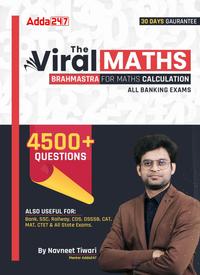Directions (1 – 5): In the given questions, two quantities are given, one as ‘Quantity I’ and another as ‘Quantity II’. You have to determine relationship between two quantities and choose the appropriate option:
Q1. Train A cross a platform of length 520 meters in 22.8 sec and a man in 7.2 sec.
Quantity I -If train A cross train B running in same direction at 96 km/hr in 63 seconds then find the length of train B.
Quantity II – What is length of train C having speed of 90 km/hr and cross train A in 7.2 sec running in opposite direction.
(a) Quantity I > Quantity II
(b) Quantity I < Quantity II
(c) Quantity I ≥ Quantity II
(d) Quantity I ≤ Quantity II
(e) Quantity I = Quantity II or no relation
Q2. Ratio of age of Bhavya & Veer three years before was 7 : 8 and after six year it will be 10 : 11. Ankit is two years older than Bhavya, while Ayush is four years younger than that of Veer. The time when Bhavya and Veer completed their graduation, the ratio of their respective ages at that time was 20 : 23
Quantity I – Sum of age of Ankit & Ayush at the time when Bhavya & Veer respectively completed their graduation.
Quantity II – Average age of P, Q & R, two years hence will be 38 years and ratio of present age of Q & R be 16 : 9. P is 33 years old, ratio of age of R & T eight years hence will be 7 : 8. M is four years older than Q and ratio of present age of M & N is 13 : 14. Find average age of N & Q.
(a) Quantity I > Quantity II
(b) Quantity I < Quantity II
(c) Quantity I ≥ Quantity II
(d) Quantity I ≤ Quantity II
(e) Quantity I = Quantity II or no relation
Q3. Length of body diagonal of a cube is 60√3 cm, if cube is melted and formed some smaller cubes with side of 4 cm each or cube is melted and formed some cuboids of each having length of 8 cm, width of 5 cm & height of 2 cm.
Quantity I – Find the difference between increase in total surface area of all smaller cubes with respect to original cube & increase in total surface area of all cuboids formed with respect to original cube (in m2).
Quantity II – 3.16 m2
(a) Quantity I > Quantity II
(b) Quantity I < Quantity II
(c) Quantity I ≥ Quantity II
(d) Quantity I ≤ Quantity II
(e) Quantity I = Quantity II or no relation
Q4. A circle with center ‘o’ is circumscribed with an equilateral triangle ABC of side 24√3 cm

Quantity I – Find the height of triangle.
Quantity II – Find the length of rectangle having perimeter 120 cm and breadth equal to radius of circle.
(a) Quantity I > Quantity II
(b) Quantity I < Quantity II
(c) Quantity I ≥ Quantity II
(d) Quantity I ≤ Quantity II
(e) Quantity I = Quantity II or no relation
Q5. Quantity I: A man has two solid balls. Ratio between radius of first ball and second ball is 4 : 3. If man cut the second ball from middle then difference between total surface area of first ball and total surface area of a part of second ball is 1424.5 cm². Find value of radius of bigger ball?
Quantity II: Height of a cylindrical vessel is equal to side of a square, having area is 256 cm². If volume of cylindrical vessel is 22176 cm³ then find the radius of cylindrical vessel.
(a) Quantity I > Quantity II
(b) Quantity I < Quantity II
(c) Quantity I ≥ Quantity II
(d) Quantity I ≤ Quantity II
(e) Quantity I = Quantity II or no relation
Solutions





. . .





 Quantitative Aptitude Quiz For Bank Main...
Quantitative Aptitude Quiz For Bank Main...
 Quantitative Aptitude Quiz For Bank Foun...
Quantitative Aptitude Quiz For Bank Foun...





